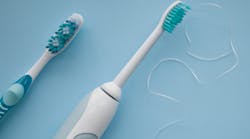I want to talk to you about using dental floss. Before you stop reading, please let me assure you I’m not going to give you a lecture here. In fact, I want to apologize on behalf of all dental professionals for nagging you about flossing. Now don’t get me wrong, we still want you to clean in between your teeth, but there’s a better way to engage you in your home care.
In the past, if your mouth wasn’t the picture of health, we dental professionals would give you 40 lashes with wet floss and a lecture about brushing and flossing. We’d probably throw in cute sayings like, “Only floss the ones you want to keep.” I want you to know it comes from a good place—but simply assuming your lack of flossing was the cause for your oral condition was shortsighted.
There are a lot more tools to home care than we are able to explain most of the time at the end of your appointment. Unfortunately, much like medicine, clinicians are pressed for time. Trying to fit all the aspects of your visit into a model that allows the business to remain profitable is challenging. There’s no reimbursement for home care instruction, so it often falls away. But that’s no excuse. As a dental hygienist and prevention specialist, I want to do better.
More popular Dear Patients:
It's safe to go back to your dental office
Your dental insurance company doesn't care about you
There’s so much more to home care than removing plaque and preventing stain and tartar build-up. We now know about biofilm, that pesky mess of microscopic microbes that cling to your teeth and gums like glue and cause all kinds of inflammation and destruction. At your hygiene visit, we’re trying to remove that biofilm, and we want you to disrupt it at home so it can’t get extra thick.That biofilm in your mouth can lead to a whole slew of other diseases. So those bleeding gums you’ve always had can actually contribute to heart disease, arthritis, Alzheimer’s disease, and more. This is why we keep bugging you about flossing. Healthy gums don’t bleed.
But I now admit that there are other ways to disrupt biofilm that might even be more effective for you than string floss. Reflexively telling you to floss is sort of like saying running is the only way to get exercise. We all know there’s yoga, CrossFit, swimming. And when choosing an exercise program, you look at your abilities, time, and preferences. The same thought should go into your home care routine.
There are so many tools on the market to help you care for your teeth. In my home care routine, I use an electric toothbrush multiple times a day. And I’ll use a water flosser, picks with pipe cleaners on the end called interdental brushes, plastic picks with a pokey end, a rubber tip, and even sometimes string floss. I don’t use each one every day, but I make sure that I’m disrupting the biofilm in between my teeth and around my gums daily.
So there you have it—my confession in writing. As a dental hygienist, I don’t floss every day. But I do disrupt the biofilm every day. And my gums don’t bleed. So next time you’re in your dental home and they ask you about flossing, find out what other tools you can be using that would work in your mouth. Your overall health will be better for it.







